Evaluation of Blockchain Applications: Bitcoin and Ethereum Features
VerifiedAdded on 2021/05/27
|13
|1224
|54
Report
AI Summary
This report provides a comprehensive analysis of two prominent blockchain applications: Bitcoin and Ethereum. It begins with an introduction to blockchain technology, defining it as a public ledger for cryptocurrency transactions. The report's aim is to discuss these applications, their features, weaknesses, and socio-technical aspects. The discussion section details the fields and purposes of both Bitcoin and Ethereum, including their roles in online transactions, decentralized applications, and smart contracts. The working models of each application are explained, highlighting how transactions are verified and added to the blockchain. Scalability issues are addressed, focusing on the limitations of transaction processing in both Bitcoin and Ethereum. The report then compares the features and weaknesses of each application, followed by a discussion of their socio-technical aspects, such as the potential impact on various industries and social groups. The report concludes by summarizing the key findings and assessing the overall purpose and implications of blockchain technology.
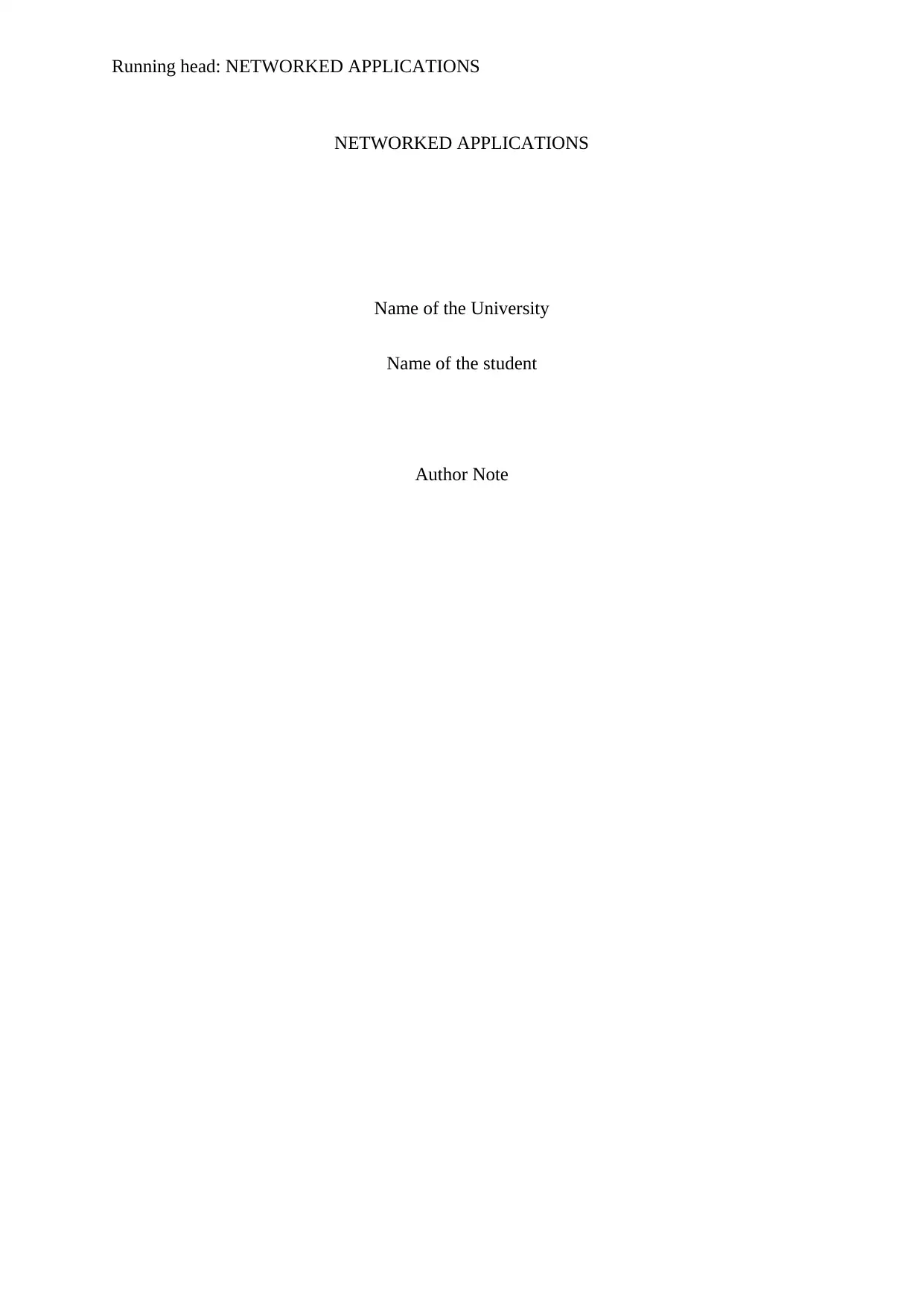
Running head: NETWORKED APPLICATIONS
NETWORKED APPLICATIONS
Name of the University
Name of the student
Author Note
NETWORKED APPLICATIONS
Name of the University
Name of the student
Author Note
Paraphrase This Document
Need a fresh take? Get an instant paraphrase of this document with our AI Paraphraser
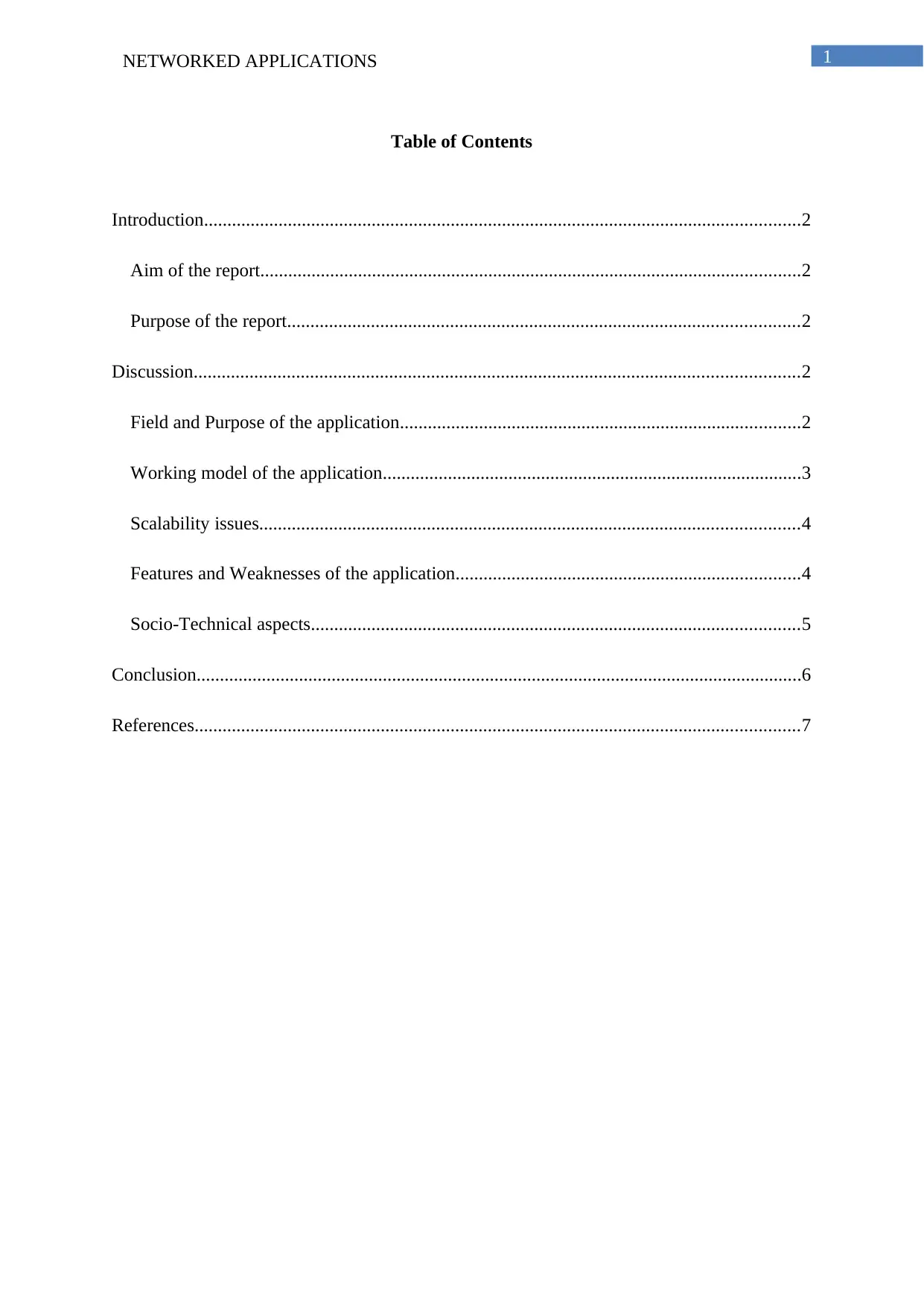
1NETWORKED APPLICATIONS
Table of Contents
Introduction................................................................................................................................2
Aim of the report....................................................................................................................2
Purpose of the report..............................................................................................................2
Discussion..................................................................................................................................2
Field and Purpose of the application......................................................................................2
Working model of the application..........................................................................................3
Scalability issues....................................................................................................................4
Features and Weaknesses of the application..........................................................................4
Socio-Technical aspects.........................................................................................................5
Conclusion..................................................................................................................................6
References..................................................................................................................................7
Table of Contents
Introduction................................................................................................................................2
Aim of the report....................................................................................................................2
Purpose of the report..............................................................................................................2
Discussion..................................................................................................................................2
Field and Purpose of the application......................................................................................2
Working model of the application..........................................................................................3
Scalability issues....................................................................................................................4
Features and Weaknesses of the application..........................................................................4
Socio-Technical aspects.........................................................................................................5
Conclusion..................................................................................................................................6
References..................................................................................................................................7
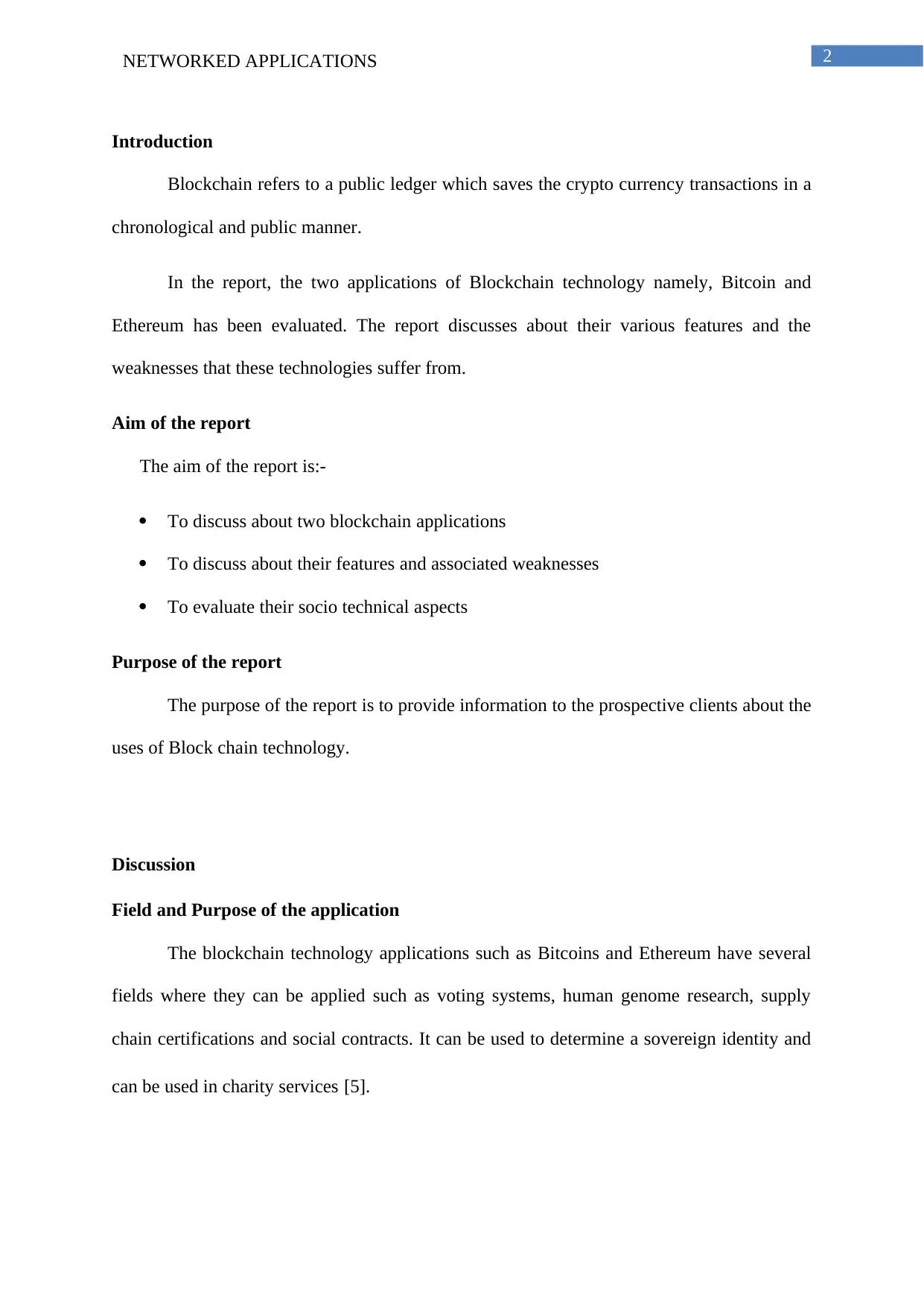
2NETWORKED APPLICATIONS
Introduction
Blockchain refers to a public ledger which saves the crypto currency transactions in a
chronological and public manner.
In the report, the two applications of Blockchain technology namely, Bitcoin and
Ethereum has been evaluated. The report discusses about their various features and the
weaknesses that these technologies suffer from.
Aim of the report
The aim of the report is:-
To discuss about two blockchain applications
To discuss about their features and associated weaknesses
To evaluate their socio technical aspects
Purpose of the report
The purpose of the report is to provide information to the prospective clients about the
uses of Block chain technology.
Discussion
Field and Purpose of the application
The blockchain technology applications such as Bitcoins and Ethereum have several
fields where they can be applied such as voting systems, human genome research, supply
chain certifications and social contracts. It can be used to determine a sovereign identity and
can be used in charity services [5].
Introduction
Blockchain refers to a public ledger which saves the crypto currency transactions in a
chronological and public manner.
In the report, the two applications of Blockchain technology namely, Bitcoin and
Ethereum has been evaluated. The report discusses about their various features and the
weaknesses that these technologies suffer from.
Aim of the report
The aim of the report is:-
To discuss about two blockchain applications
To discuss about their features and associated weaknesses
To evaluate their socio technical aspects
Purpose of the report
The purpose of the report is to provide information to the prospective clients about the
uses of Block chain technology.
Discussion
Field and Purpose of the application
The blockchain technology applications such as Bitcoins and Ethereum have several
fields where they can be applied such as voting systems, human genome research, supply
chain certifications and social contracts. It can be used to determine a sovereign identity and
can be used in charity services [5].
⊘ This is a preview!⊘
Do you want full access?
Subscribe today to unlock all pages.

Trusted by 1+ million students worldwide
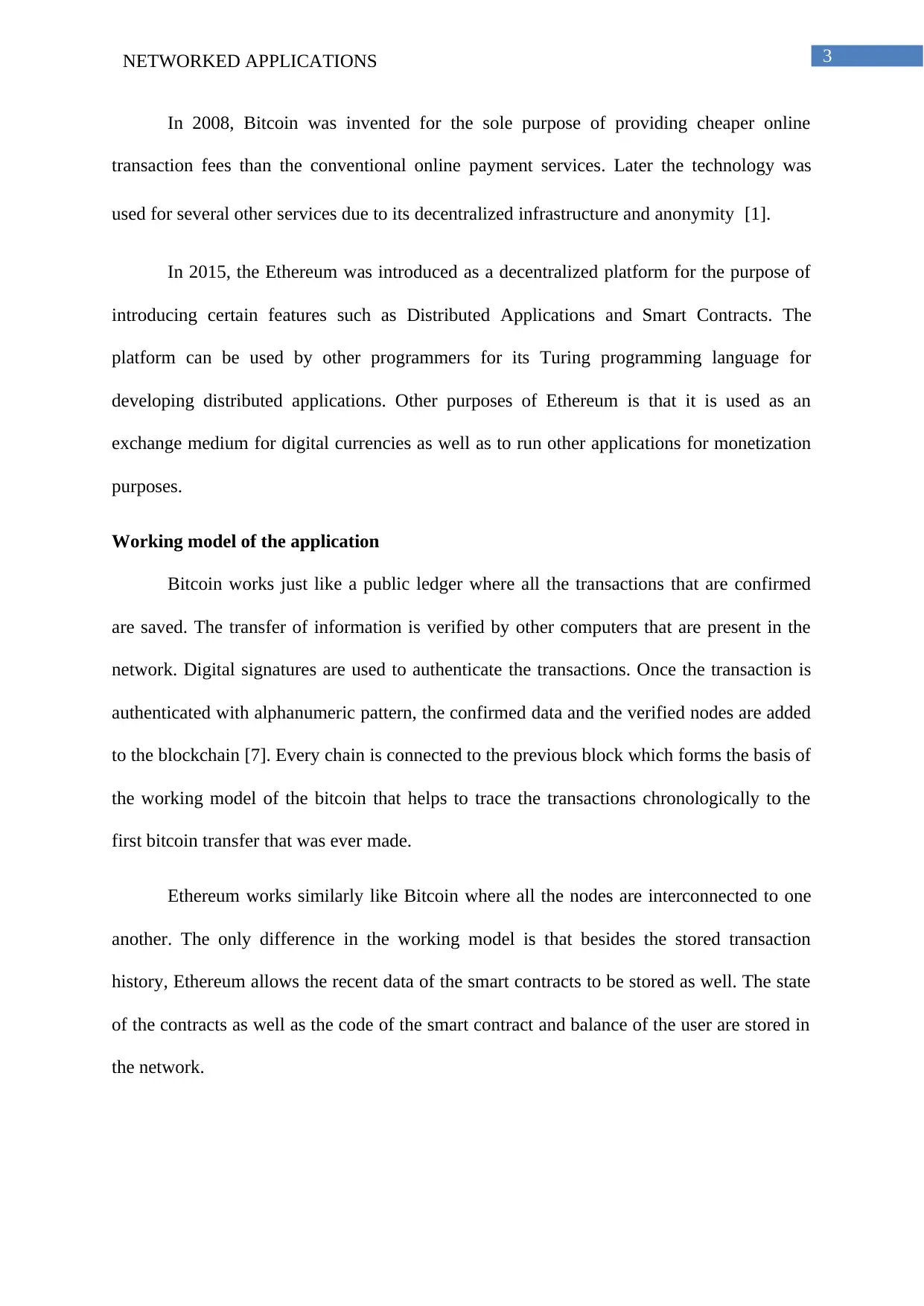
3NETWORKED APPLICATIONS
In 2008, Bitcoin was invented for the sole purpose of providing cheaper online
transaction fees than the conventional online payment services. Later the technology was
used for several other services due to its decentralized infrastructure and anonymity [1].
In 2015, the Ethereum was introduced as a decentralized platform for the purpose of
introducing certain features such as Distributed Applications and Smart Contracts. The
platform can be used by other programmers for its Turing programming language for
developing distributed applications. Other purposes of Ethereum is that it is used as an
exchange medium for digital currencies as well as to run other applications for monetization
purposes.
Working model of the application
Bitcoin works just like a public ledger where all the transactions that are confirmed
are saved. The transfer of information is verified by other computers that are present in the
network. Digital signatures are used to authenticate the transactions. Once the transaction is
authenticated with alphanumeric pattern, the confirmed data and the verified nodes are added
to the blockchain [7]. Every chain is connected to the previous block which forms the basis of
the working model of the bitcoin that helps to trace the transactions chronologically to the
first bitcoin transfer that was ever made.
Ethereum works similarly like Bitcoin where all the nodes are interconnected to one
another. The only difference in the working model is that besides the stored transaction
history, Ethereum allows the recent data of the smart contracts to be stored as well. The state
of the contracts as well as the code of the smart contract and balance of the user are stored in
the network.
In 2008, Bitcoin was invented for the sole purpose of providing cheaper online
transaction fees than the conventional online payment services. Later the technology was
used for several other services due to its decentralized infrastructure and anonymity [1].
In 2015, the Ethereum was introduced as a decentralized platform for the purpose of
introducing certain features such as Distributed Applications and Smart Contracts. The
platform can be used by other programmers for its Turing programming language for
developing distributed applications. Other purposes of Ethereum is that it is used as an
exchange medium for digital currencies as well as to run other applications for monetization
purposes.
Working model of the application
Bitcoin works just like a public ledger where all the transactions that are confirmed
are saved. The transfer of information is verified by other computers that are present in the
network. Digital signatures are used to authenticate the transactions. Once the transaction is
authenticated with alphanumeric pattern, the confirmed data and the verified nodes are added
to the blockchain [7]. Every chain is connected to the previous block which forms the basis of
the working model of the bitcoin that helps to trace the transactions chronologically to the
first bitcoin transfer that was ever made.
Ethereum works similarly like Bitcoin where all the nodes are interconnected to one
another. The only difference in the working model is that besides the stored transaction
history, Ethereum allows the recent data of the smart contracts to be stored as well. The state
of the contracts as well as the code of the smart contract and balance of the user are stored in
the network.
Paraphrase This Document
Need a fresh take? Get an instant paraphrase of this document with our AI Paraphraser
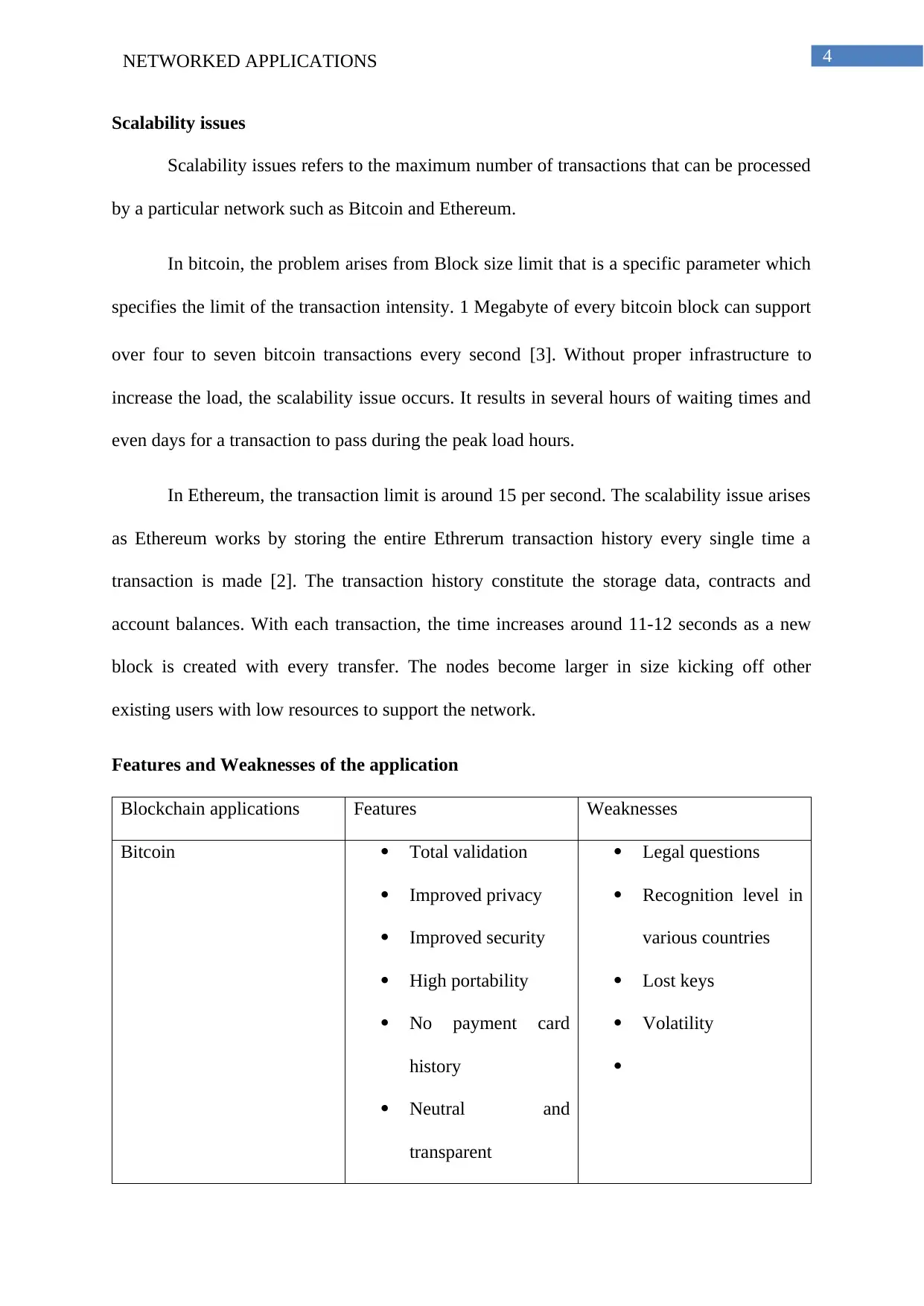
4NETWORKED APPLICATIONS
Scalability issues
Scalability issues refers to the maximum number of transactions that can be processed
by a particular network such as Bitcoin and Ethereum.
In bitcoin, the problem arises from Block size limit that is a specific parameter which
specifies the limit of the transaction intensity. 1 Megabyte of every bitcoin block can support
over four to seven bitcoin transactions every second [3]. Without proper infrastructure to
increase the load, the scalability issue occurs. It results in several hours of waiting times and
even days for a transaction to pass during the peak load hours.
In Ethereum, the transaction limit is around 15 per second. The scalability issue arises
as Ethereum works by storing the entire Ethrerum transaction history every single time a
transaction is made [2]. The transaction history constitute the storage data, contracts and
account balances. With each transaction, the time increases around 11-12 seconds as a new
block is created with every transfer. The nodes become larger in size kicking off other
existing users with low resources to support the network.
Features and Weaknesses of the application
Blockchain applications Features Weaknesses
Bitcoin Total validation
Improved privacy
Improved security
High portability
No payment card
history
Neutral and
transparent
Legal questions
Recognition level in
various countries
Lost keys
Volatility
Scalability issues
Scalability issues refers to the maximum number of transactions that can be processed
by a particular network such as Bitcoin and Ethereum.
In bitcoin, the problem arises from Block size limit that is a specific parameter which
specifies the limit of the transaction intensity. 1 Megabyte of every bitcoin block can support
over four to seven bitcoin transactions every second [3]. Without proper infrastructure to
increase the load, the scalability issue occurs. It results in several hours of waiting times and
even days for a transaction to pass during the peak load hours.
In Ethereum, the transaction limit is around 15 per second. The scalability issue arises
as Ethereum works by storing the entire Ethrerum transaction history every single time a
transaction is made [2]. The transaction history constitute the storage data, contracts and
account balances. With each transaction, the time increases around 11-12 seconds as a new
block is created with every transfer. The nodes become larger in size kicking off other
existing users with low resources to support the network.
Features and Weaknesses of the application
Blockchain applications Features Weaknesses
Bitcoin Total validation
Improved privacy
Improved security
High portability
No payment card
history
Neutral and
transparent
Legal questions
Recognition level in
various countries
Lost keys
Volatility
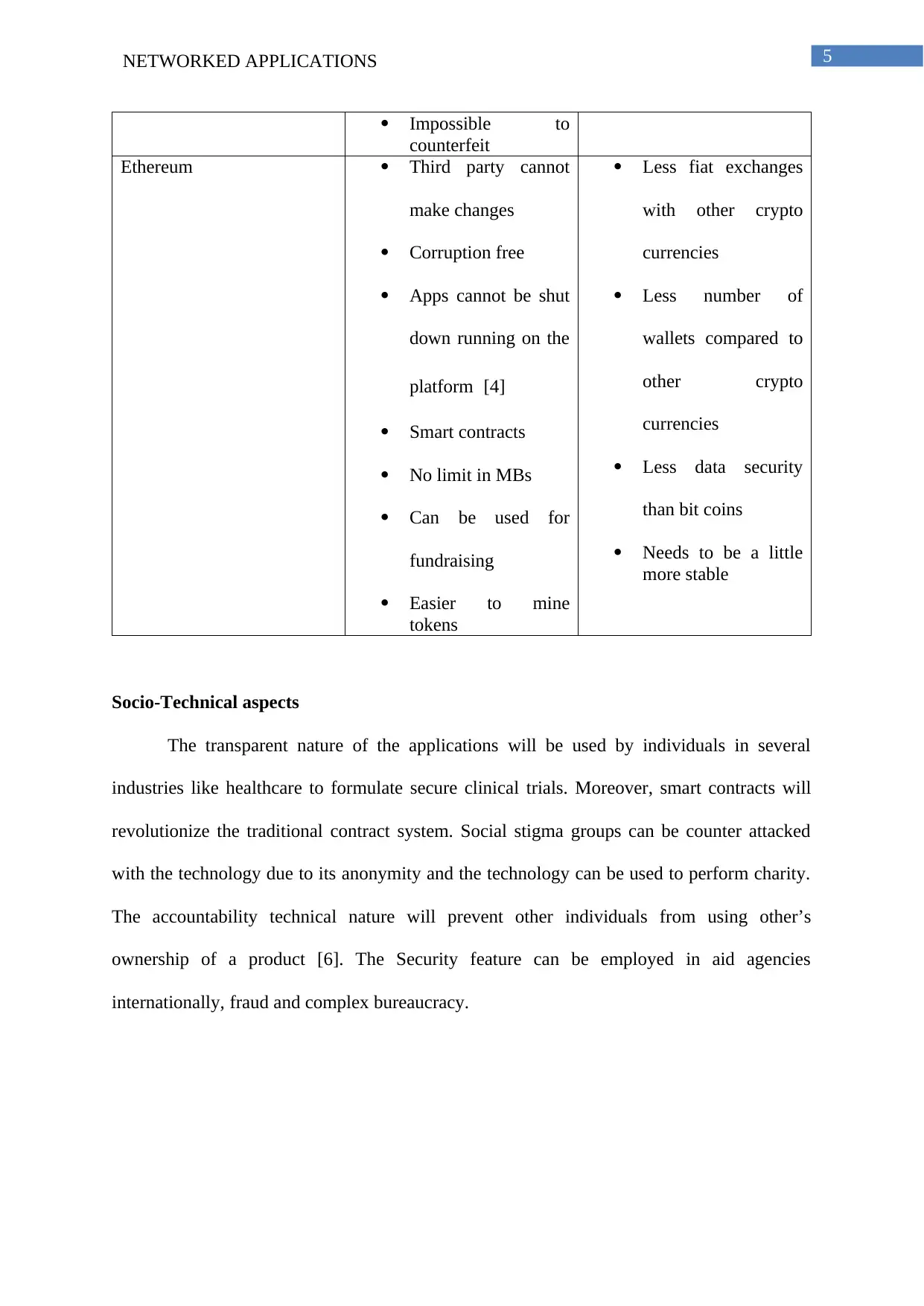
5NETWORKED APPLICATIONS
Impossible to
counterfeit
Ethereum Third party cannot
make changes
Corruption free
Apps cannot be shut
down running on the
platform [4]
Smart contracts
No limit in MBs
Can be used for
fundraising
Easier to mine
tokens
Less fiat exchanges
with other crypto
currencies
Less number of
wallets compared to
other crypto
currencies
Less data security
than bit coins
Needs to be a little
more stable
Socio-Technical aspects
The transparent nature of the applications will be used by individuals in several
industries like healthcare to formulate secure clinical trials. Moreover, smart contracts will
revolutionize the traditional contract system. Social stigma groups can be counter attacked
with the technology due to its anonymity and the technology can be used to perform charity.
The accountability technical nature will prevent other individuals from using other’s
ownership of a product [6]. The Security feature can be employed in aid agencies
internationally, fraud and complex bureaucracy.
Impossible to
counterfeit
Ethereum Third party cannot
make changes
Corruption free
Apps cannot be shut
down running on the
platform [4]
Smart contracts
No limit in MBs
Can be used for
fundraising
Easier to mine
tokens
Less fiat exchanges
with other crypto
currencies
Less number of
wallets compared to
other crypto
currencies
Less data security
than bit coins
Needs to be a little
more stable
Socio-Technical aspects
The transparent nature of the applications will be used by individuals in several
industries like healthcare to formulate secure clinical trials. Moreover, smart contracts will
revolutionize the traditional contract system. Social stigma groups can be counter attacked
with the technology due to its anonymity and the technology can be used to perform charity.
The accountability technical nature will prevent other individuals from using other’s
ownership of a product [6]. The Security feature can be employed in aid agencies
internationally, fraud and complex bureaucracy.
⊘ This is a preview!⊘
Do you want full access?
Subscribe today to unlock all pages.

Trusted by 1+ million students worldwide

6NETWORKED APPLICATIONS
Conclusion
To conclude the report, it can be stated that the purpose of the Blockchain technology
has been assessed with its two provided applications. The working model of the applications
has been assessed and the scalability issues have been evaluated. Moreover, the weaknesses
and features of the applications have been discussed in the report as well. Lastly, the socio
technical aspects of the technology has been discussed in the report.
Conclusion
To conclude the report, it can be stated that the purpose of the Blockchain technology
has been assessed with its two provided applications. The working model of the applications
has been assessed and the scalability issues have been evaluated. Moreover, the weaknesses
and features of the applications have been discussed in the report as well. Lastly, the socio
technical aspects of the technology has been discussed in the report.
Paraphrase This Document
Need a fresh take? Get an instant paraphrase of this document with our AI Paraphraser
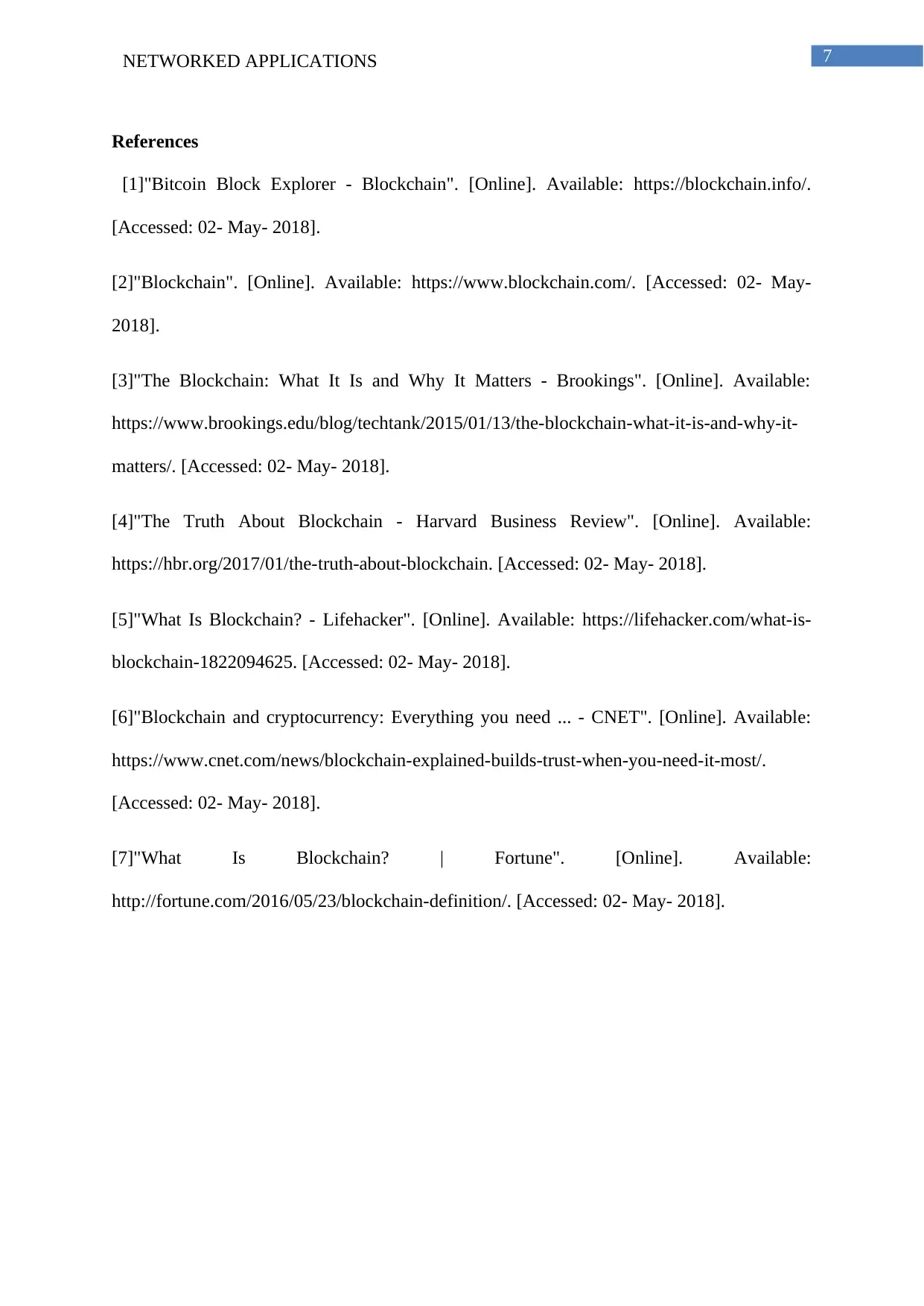
7NETWORKED APPLICATIONS
References
[1]"Bitcoin Block Explorer - Blockchain". [Online]. Available: https://blockchain.info/.
[Accessed: 02- May- 2018].
[2]"Blockchain". [Online]. Available: https://www.blockchain.com/. [Accessed: 02- May-
2018].
[3]"The Blockchain: What It Is and Why It Matters - Brookings". [Online]. Available:
https://www.brookings.edu/blog/techtank/2015/01/13/the-blockchain-what-it-is-and-why-it-
matters/. [Accessed: 02- May- 2018].
[4]"The Truth About Blockchain - Harvard Business Review". [Online]. Available:
https://hbr.org/2017/01/the-truth-about-blockchain. [Accessed: 02- May- 2018].
[5]"What Is Blockchain? - Lifehacker". [Online]. Available: https://lifehacker.com/what-is-
blockchain-1822094625. [Accessed: 02- May- 2018].
[6]"Blockchain and cryptocurrency: Everything you need ... - CNET". [Online]. Available:
https://www.cnet.com/news/blockchain-explained-builds-trust-when-you-need-it-most/.
[Accessed: 02- May- 2018].
[7]"What Is Blockchain? | Fortune". [Online]. Available:
http://fortune.com/2016/05/23/blockchain-definition/. [Accessed: 02- May- 2018].
References
[1]"Bitcoin Block Explorer - Blockchain". [Online]. Available: https://blockchain.info/.
[Accessed: 02- May- 2018].
[2]"Blockchain". [Online]. Available: https://www.blockchain.com/. [Accessed: 02- May-
2018].
[3]"The Blockchain: What It Is and Why It Matters - Brookings". [Online]. Available:
https://www.brookings.edu/blog/techtank/2015/01/13/the-blockchain-what-it-is-and-why-it-
matters/. [Accessed: 02- May- 2018].
[4]"The Truth About Blockchain - Harvard Business Review". [Online]. Available:
https://hbr.org/2017/01/the-truth-about-blockchain. [Accessed: 02- May- 2018].
[5]"What Is Blockchain? - Lifehacker". [Online]. Available: https://lifehacker.com/what-is-
blockchain-1822094625. [Accessed: 02- May- 2018].
[6]"Blockchain and cryptocurrency: Everything you need ... - CNET". [Online]. Available:
https://www.cnet.com/news/blockchain-explained-builds-trust-when-you-need-it-most/.
[Accessed: 02- May- 2018].
[7]"What Is Blockchain? | Fortune". [Online]. Available:
http://fortune.com/2016/05/23/blockchain-definition/. [Accessed: 02- May- 2018].
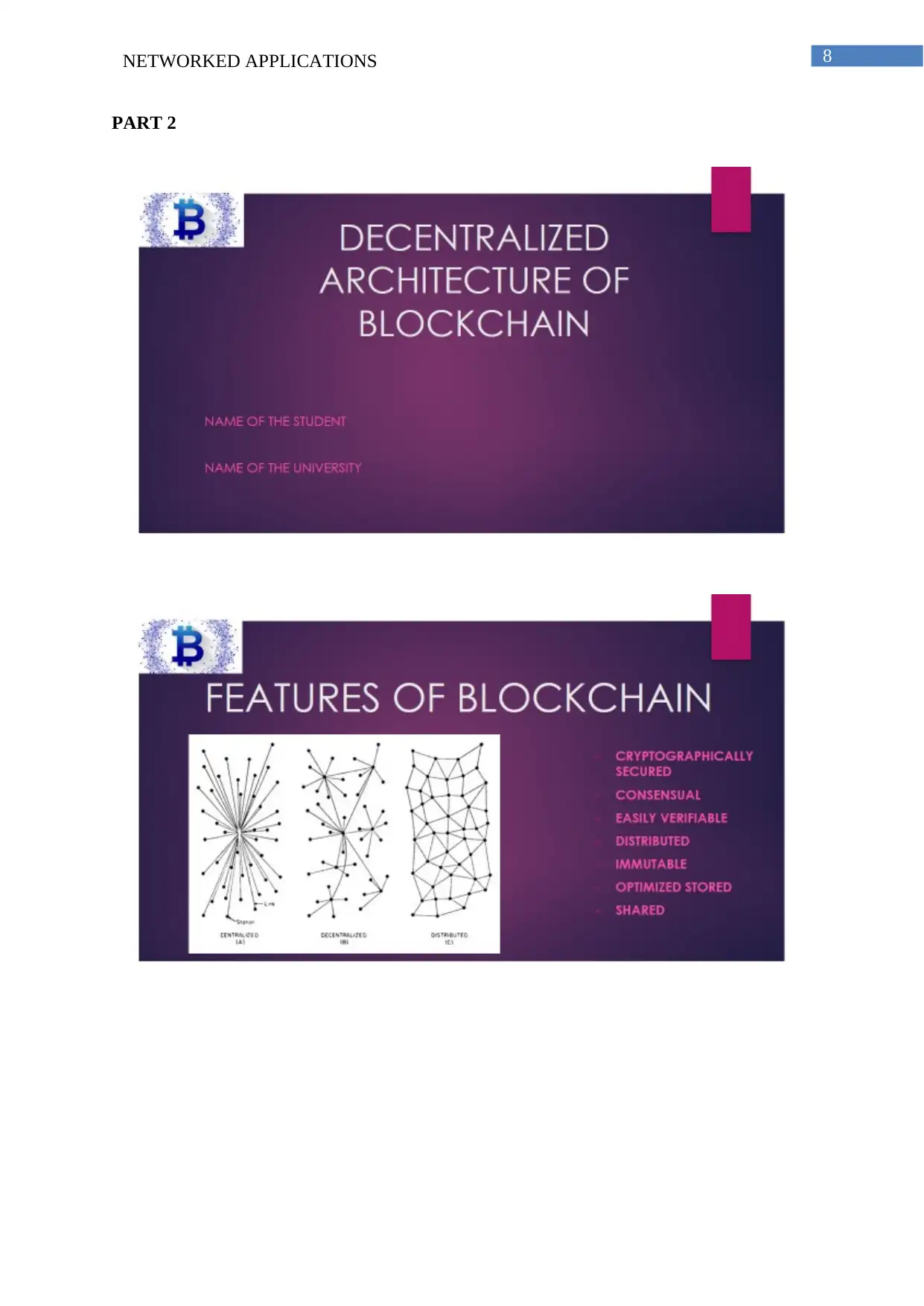
8NETWORKED APPLICATIONS
PART 2
PART 2
⊘ This is a preview!⊘
Do you want full access?
Subscribe today to unlock all pages.

Trusted by 1+ million students worldwide
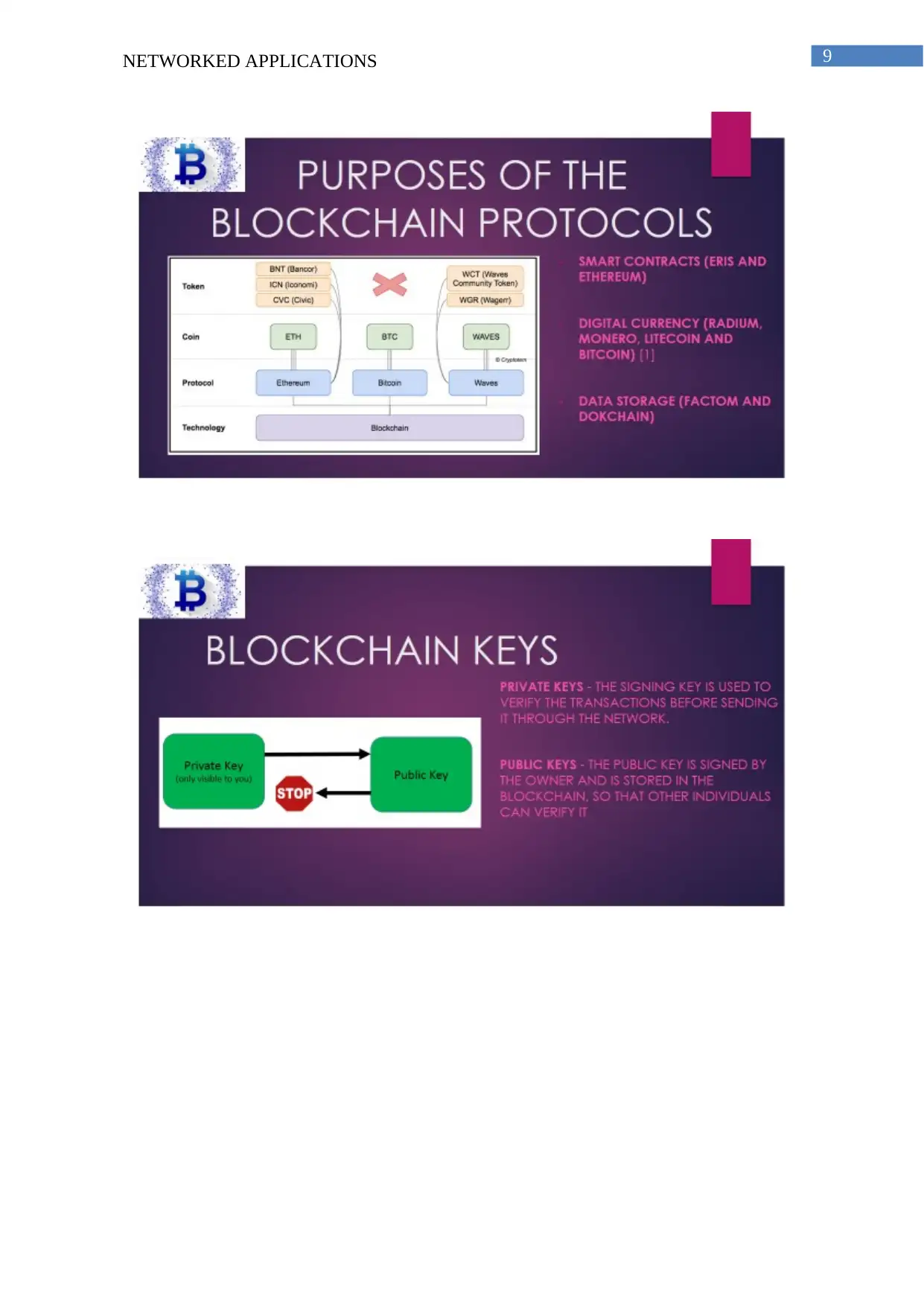
9NETWORKED APPLICATIONS
Paraphrase This Document
Need a fresh take? Get an instant paraphrase of this document with our AI Paraphraser
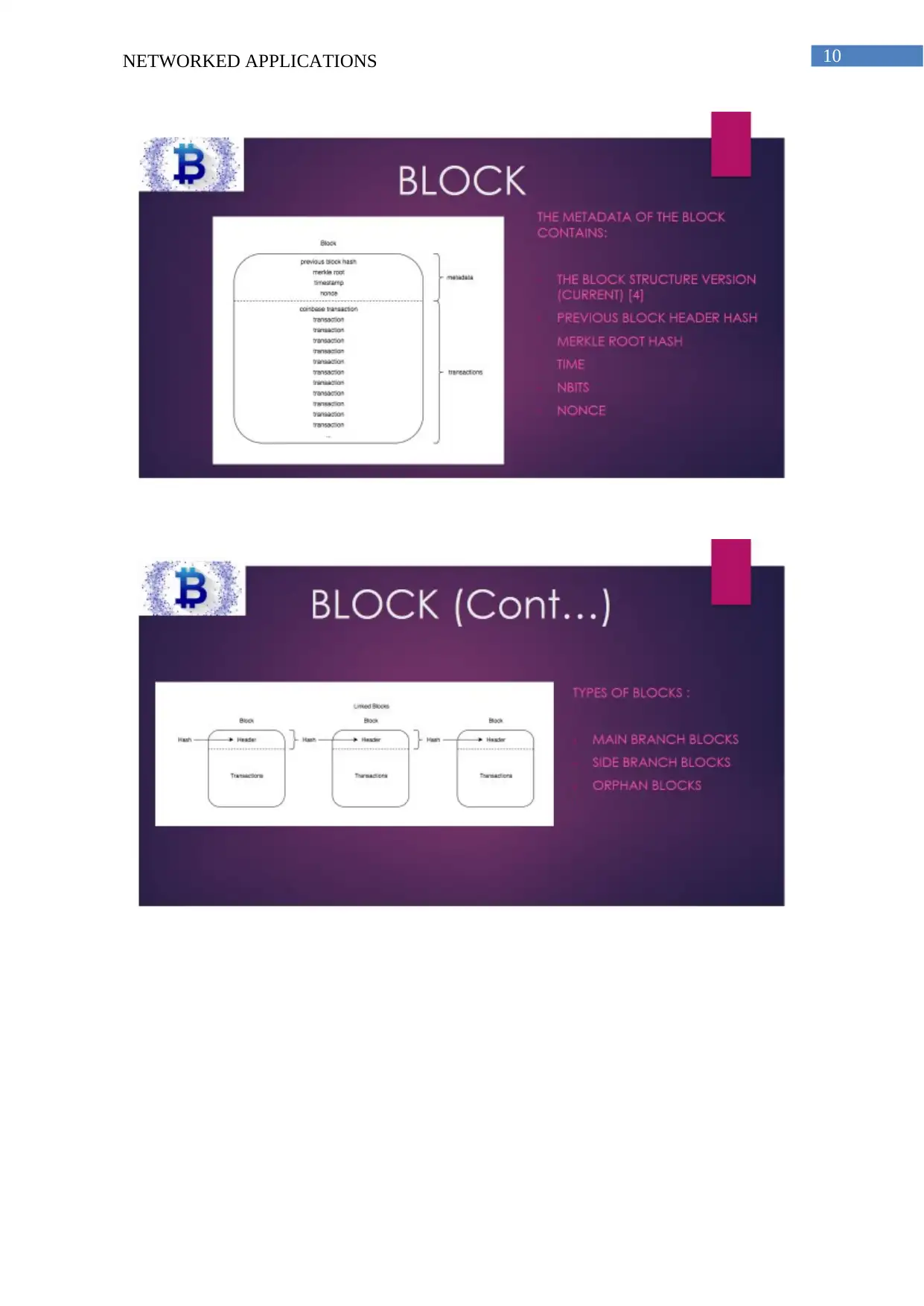
10NETWORKED APPLICATIONS
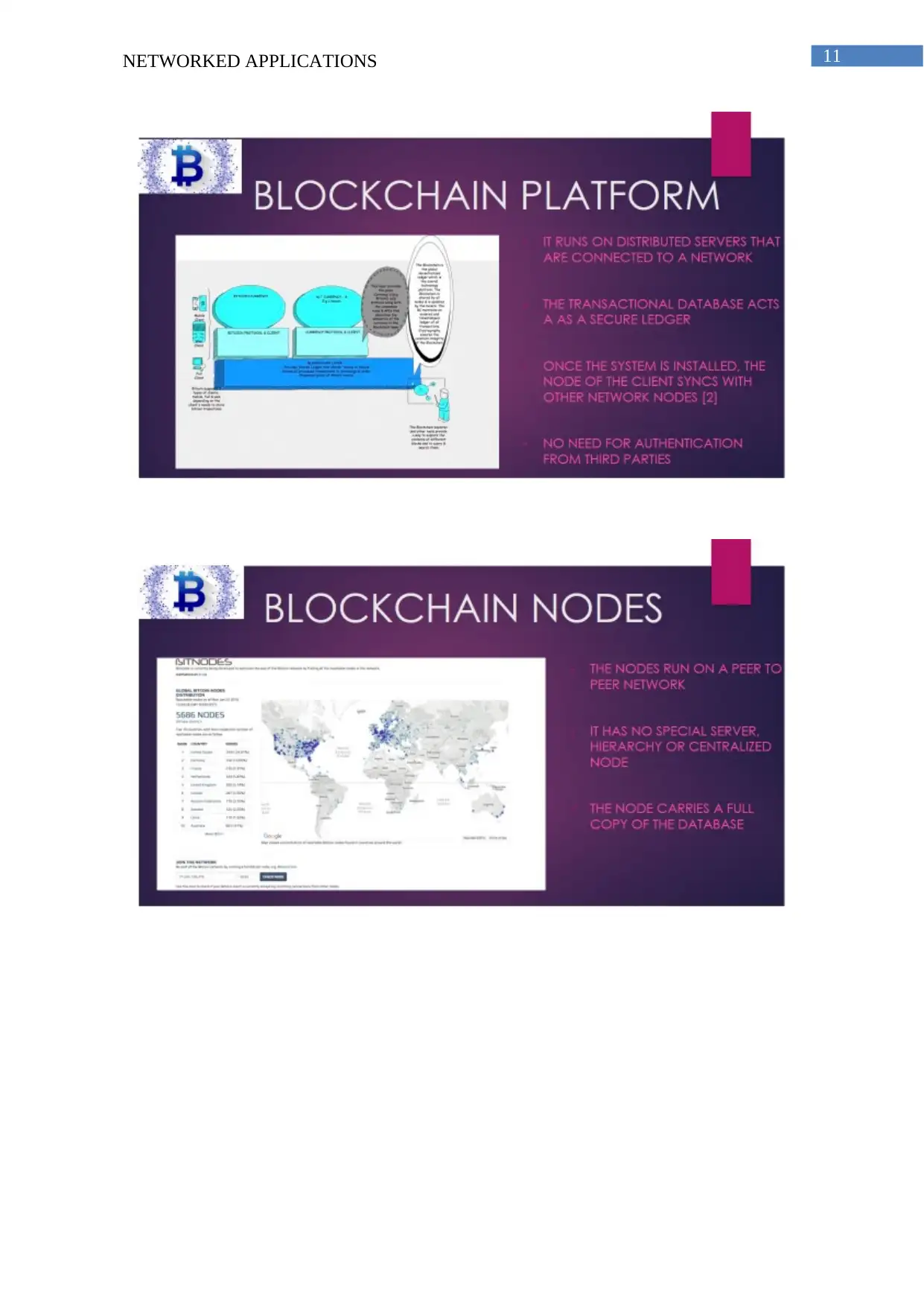
11NETWORKED APPLICATIONS
⊘ This is a preview!⊘
Do you want full access?
Subscribe today to unlock all pages.

Trusted by 1+ million students worldwide
1 out of 13
Related Documents
Your All-in-One AI-Powered Toolkit for Academic Success.
+13062052269
info@desklib.com
Available 24*7 on WhatsApp / Email
![[object Object]](/_next/static/media/star-bottom.7253800d.svg)
Unlock your academic potential
Copyright © 2020–2025 A2Z Services. All Rights Reserved. Developed and managed by ZUCOL.





